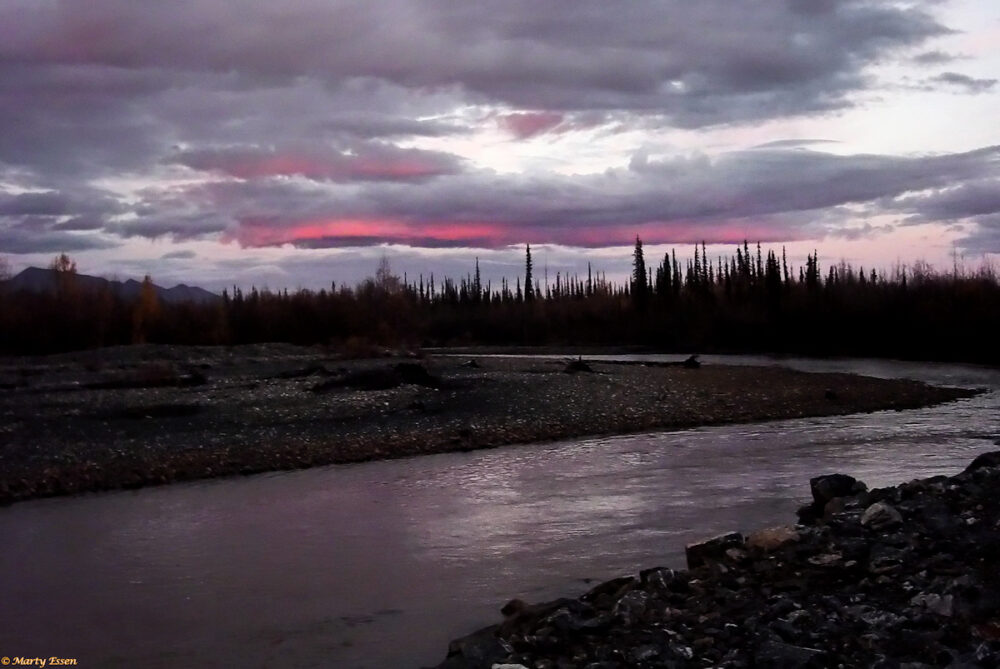
Marty’s photo of the day #4216: I shot this photo from the best campsite of Deb’s and my adventure to the top of Canada and back. This short excerpt from my first book, Cool Creatures, Hot Planet: Exploring the Seven Continents, tells the story:
The rest of our afternoon was uneventful—if you can call driving through spectacular scenery uneventful. The first established place to pitch our tent south of the Arctic Circle was at Engineer Creek Campground, 150 miles past the caribou. I had low expectations for the spot. If you recall, Engineer Creek was the river that reeked of sulfur. Also, for me, nothing with the word “engineer” in it inspires thoughts of communing with nature.
This day, though, was one of those few magical days each person gets in a lifetime where everything exceeds expectations. The campground turned out to be wooded, rustic, and, best of all, uninhabited. We had our choice of fifteen campsites and selected the one at the edge of the river.
As a reward for spending the afternoon in the truck, we let Kate swim as often as she desired—now even her day exceeded expectations. I sniffed the air. No sulfur. The river flowed north toward where we had observed the Dall sheep, and the sulfur springs had yet to taint the water.
Deb and I finished setting up camp just in time to watch the sunset. Our tent sat on the western riverbank. Opposite us was a stony beach, fringed by a forest of dark-green pine and vibrant-yellow alder abutting the base of a towering craggy butte. In the west, the sun painted the clouds, creating a fiery canvas of blaze orange and molten red, and in the east, the butte reflected the sunset, glowing as if made of burnished gold. Both views, west and east, were equally intoxicating.
Having savored the Porcupine caribou migration, enjoyed the brilliant fall colors, and relished the intense sunset, we retired to our tent. Once cocooned in our sleeping bags, we flicked on our headlamps and relaxed with our books. While we read, the river’s gentle gurgle accompanied us. Soon we grew drowsy and opted for darkness.
As the two of us drifted toward dreamland, something to the west began whimpering. We were barely conscious of the sound until it crescendoed into a howl.
A wolf was next to our tent!
Almost immediately a wolf from across the river answered the howl, and another to the north added harmony. I braced myself up on my elbows so I could hear better but kept my headlamp off. Though I couldn’t see Deb, I sensed her smile. As for the dogs, they surprised me by listening without barking or growling.
An opera of howls echoed around us as the rest of the pack joined in. Their music—in true surround sound—was especially haunting at night.
At the beginning of the trip, when I mentioned to Deb my wish to hear wolves howling around our tent, I was thinking they’d be far off in the woods. Judging distance based solely on sound is subjective, but my guess is that the first wolf was fifteen feet from our tent and the others were spaced from fifty to two hundred feet away.
The opera ceased after a few minutes. A single wolf howled near the butte an hour later, and solo performances serenaded us from time to time throughout the night. Though we never heard the pack as a chorus again, for the first time in my life wake-up calls were something I looked forward to.
Deb had a theory about the wolves that made perfect sense. When we were reading, the light from our headlamps made our nylon tent glow, and the glowing caught the wolves’ attention. The whimpering we heard was from a wolf who had been sent to scout us out, and his first howl was a message to the pack on the status of our tent: “No, the mother ship hasn’t returned for us yet. It’s just more of those stinky humans.” The entire pack then howled to acknowledge the message, and the subsequent solo howls were periodic announcements that we were still in the area.
Miles traveled so far: 3,071